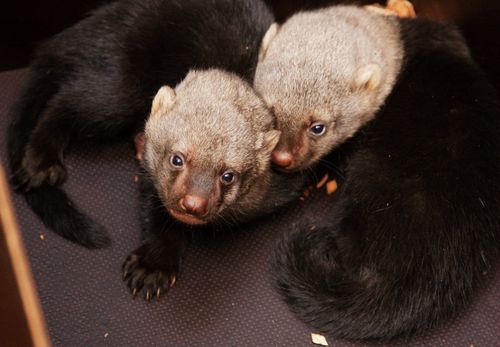
Tayra(Eira barbara)
Phylum —chordata
Class — mammalia
Order — carnivora
Family — mustelidae
Genus – eira
Appearance
Tayras are long, slender animals with an appearance similar to that of weasels and martens. They range from 56 to 71 cm (22 to 28 in) in length, not including a 37- to 46-cm-long (15 to 18 in) bushy tail, and weigh 2.7 to 7.0 kg (6.0 to 15.4 lb). Males are larger, and slightly more muscular, than females.
They have short, dark brown to black fur which is relatively uniform across the body, limbs, and tail, except for a yellow or orange spot on the chest. The fur on the head and neck is much paler, typically tan or greyish in colour.
Habitat
Tayras are found across most of South America east of the Andes, except for Uruguay, eastern Brazil, and all but the most northerly parts of Argentina. They are also found across the whole of Central America, in Mexico as far north as southern Veracruz, and on the island of Trinidad.
Behavior
Tayras are diurnal animals, although occasionally active during the evening or at night. They usually travel alone or in pairs, but occasionally can be seen in small groups of 3-4 individuals.
They usually move rapidly through the trees or on the ground. Tayras are very fast runners and despite their poor eyesight are excellent climbers as well. They are able to climb down smooth tree trunks from heights of more than 40 meters. On the ground or on large horizontal tree limbs, they use a bounding gallop when moving at high speeds. They can also leap from treetop to treetop when pursued. They generally avoid water but are capable of swimming across rivers when necessary. They locate prey primarily by scent, and actively chase it once located, rather than stalking or using ambush tactics.
Tayras live in hollow trees or burrows in the ground. Individual animals maintain relatively large home ranges, with areas up to 24 km2 (9.3 sq mi). They may travel at least 6 km (3.7 mi) in a single night.
These are usually silent animals, but when alarmed, tayras produce a short, barking call and may snort, growl, and spit while seeking protection in a nearby tree. They can also communicate with the help of yowls, snarls or clicks when in groups.
Diet
Tayras are opportunistic omnivores, hunting rodents, and other small mammals, as well as birds, lizards, and invertebrates. They will also climb trees to get fruit and honey.
Reproduction
Tayras breed year-round and gestation lasts from 63 to 67 days. Females give birth to 1-3 young, which they care for alone. The young are altricial, being born blind and with closed ears, but are already covered in a full coat of black fur. They weigh about 100 g (3.5 oz) at birth. Their eyes open at 35 to 47 days, and they leave the den shortly thereafter. They begin to take solid food around 70 days of age and are fully weaned by 100 days. Hunting behavior begins as early as three months, and the mother initially brings her offspring wounded or slow prey to practice on as they improve their killing technique. The young are fully grown around 6 months old, and leave their mother to establish their own territory by 10 months.
In captivity
Tayra has a relatively long lifespan of 18-22 years in captivity.
It is better to keep it in a cage but it is necessary to give it an opportunity to walkdaily around the room. You can keep it just in the apartment, but in this case there is a risk of losing the animal if it suddenly accidentally jumps out through an open door, a window or a balcony. Therefore, it is not recommended to leave the tayra walking around the apartment without supervision.
Its diet should consists of day-old chickens, mice, rats, and other rodents. It is necessary to add plant food.
 Russian
Russian
 English
English























